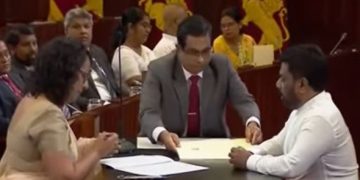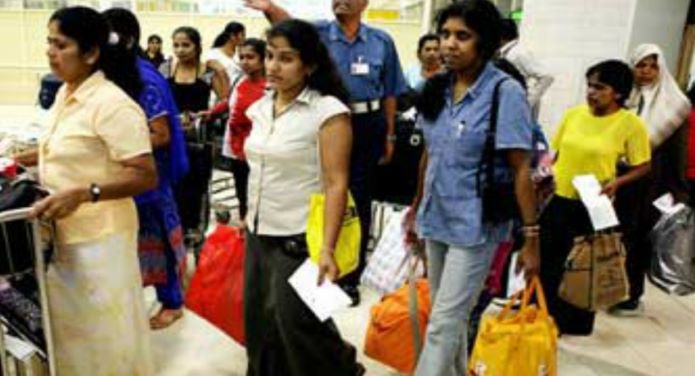By P.K.Balachandran
Colombo, November 17 (newsin.asia): The number of Sri Lankans wanting to emigrate has doubled in the last 3 to 5 years. Presently, 27% would like to emigrate, the Sri Lanka Opinion Tracker Survey (SLOTS) has revealed.
Dr. Ravi Rannan-Eliya of the Institute for Health Policy, who led the study said: “Comparisons with earlier years is difficult as the SLOTS survey is new, but comparison with earlier surveys, which used the same questions, implies that the number of Sri Lankans who want to emigrate has doubled during the last three to five years, and this can be taken as a reasonable indicator of potential emigration, both legal and undocumented, from Sri Lanka once global travel restrictions imposed in response to COVID-19 are lifted.”
Subscribe to our Telegram channel for the latest updates from around the world
The study found that males are more likely than females to want to emigrate, if given the chance. But the group expressing the greatest desire to emigrate are the youth (between ages 18 and 29 years) and university graduates. Half of this group would like to emigrate. Among those in the Tamil-speaking Northern and Eastern provinces, 2 in 5 would like to emigrate if given the chance.
Only Some Can Actually Though
The study however found that only some can actually migrate.
“It should be noted that in terms of translating the desire to migrate into actual plans, the better-off and more educated are far more likely to have started preparations, demonstrating that personal resources are also a key factor enabling Sri Lankans to migrate,” the study said.
READ: UAE National Day: Manike Mage Hithe hitmaker Yohani to perform in Dubai
The study confirms Prime Minister Mahinda Rajapaksa’s point that it’s the youth who most want to emigrate. The PM was speaking to his party cadres recently in which castigated the government of his bother Gotabaya Rajapaksa.
Disenchantment
The survey asked if the people were disenchanted with the government of the Rajapaksas It found that voters’ disenchantment with their choice in the 2019 Presidential and in the 2020 parliamentary elections was sizeable.
Of respondents who said that they voted for President Gotabaya Rajapaksa in 2019 and the Sri Lanka Podujana Peramuna (SLPP) in the 2020 parliamentary elections, 1 in 3 were “disenchanted”. Significantly, they did not choose President Gotabaya Rajapaksa when asked how they would vote if there was an election today.
Some indicated other individuals as their choice, but most said that they would not vote or they refused to answer, suggesting that much of the disenchantment with the government does not translate yet into support for the Opposition parties.
READ: Sri Lanka Budget 2022 Summary
Lack of Hope
It also suggests that the increased desire to migrate may reflect wider despair about the ability of the political system to offer a change for the better, the study reveals.
When accounting for all factors in combination, it was found that only some have the means to give effect to the desire to emigrate. Women, older people, and the less educated and the not so well off, have less of a chance to actually migrate. On the other hand, the youth, males, the more educated, those living in Northern and Eastern provinces and in the urban areas, and the economically better-off are more likely to actually migrate.
Among those who wanted to migrate, disenchanted Rajapaksa voters were three times more than the Rajapaksa loyalists. This would confirm Prime Minister Mahinda Rajapaksa’s second point that disenchantment with the government is pushing former supporters to migrate.
READ: Sri Lanka approves anti-Covid pill Molnupiravir
66% of the disenchanted Rajapaksa voters assessed that their own household economic situation had gone down. In the case of the Rajapaksa loyalists, the figure was 56%. Disenchanted Rajapaksa voters were more pessimistic about the prospects for the economy, with 66% saying they expect the economy to be worse in a year’s time. Only 59% of loyal voters said so.
Disenchanted Rajapaksa voters were also less satisfied than the loyal voters with the government’s COVID-19 response/management. When asked how they assessed the government’s response, only 47% assessed it as good, much less than loyal voters (74%). They also favored much stronger control of COVID-19 in future and would not tolerate more than 100 deaths a year. Loyalists would tolerate 1000 deaths a year.
READ: Chinese fertilizer company says Sri Lanka will be taken to FAO over false allegations
Summing up the report says: “Responses in the Sri Lanka Opinion Tracker Survey corroborate Prime Minister Mahinda Rajapaksa’s claim that there is a surge in Sri Lankans, especially the youth, trying to migrate, and they confirm that much of this is driven by disenchantment of voters with the government. “
“They also indicate that much of this dissatisfaction is driven by pessimism about economic prospects and dissatisfaction with the COVID-19 response, in particular a preference for stronger control of COVID-19 versus just living with the virus”.
“The only positive aspect of this for the government might be that many disenchanted Rajapaksa voters do not appear to have switched their support to other parties, but this might only be a matter of time.”
“However, from a national perspective the increased pressures to emigrate by the youth and the most educated and affluent in society bodes badly for the country’s future economic and social prospects as global travel restrictions are lifted.”
READ: COVID: Pfizer to allow developing nations to make its treatment pill
Grim Economic Situation
According to KPMG, Sri Lanka’s GDP contracted by 3.6% in 2020 due to COVID pandemic, lockdowns, supply restrictions and loss of taxes due to disruption to economic activities, and tax concessions.
The government is expecting the economy to grow by 8% in 2021 but the World Bank and IMF put the expected growth rate at 3.4% and 4% respectively.
Due to various health and lockdown restrictions and also a total ban on the use of chemical fertilizer in the absence of organic fertilizer, the agriculture sector contracted by 2.4% in 2020.
READ: Lankan economy will gain substantially by reducing road accidents
The Services and Industrial sectors contracted by 1.5% and 6.9 % respectively. The tourism sector, which got 2.5 million arrivals in 2018, got only 507,704 in 2020 partly due to the Easter Sunday bomb blasts and partly due to COVID lockdowns. Unemployment rose to 5.8% in 2020 and is 5.6% so far in 2021.
Post 2020 parliamentary elections, there were massive tax cuts to fulfill manifesto promises. Between 2019 and 2020, tax revenue declined from 12.6% of GDP to 9.2% of GDP. Tax collection fell further in 2021 due to import restrictions caused by a lack of foreign exchange. This resulted in a budget deficit of Rs.520.5 billion in the first quarter of 2021.
In 2020, Sri Lanka had to pay US$ 4.3 billion towards repayment of foreign debt (US$ 2.8 billion as principle and US$ 1.5 billion as interest.) In 2020, the debt to GDP ratio was 101%.
At the end of April 2021, Sri Lanka’s outstanding foreign debt was US$ 35.1 billion of which 46% was the result of International Sovereign Bonds (ISB). In 2022, Sri Lanka will have to pay back debt to the tune of US$ 5 billion.
Sri Lanka’s foreign reserves in October 2021 was US$ 2.3 billion. The Sri Lankan rupee declined by 2.6% against the US dollar in 2020.
Both rating agencies, S and P and Moody’s, have downgraded Sri Lanka.
The annual budget for 2022 presented recently attempts to pour money into various sectors to stimulate growth and demand. If implemented efficiently and without further lockdowns, the economy may start functioning again. But implementation is a major stumbling block in Sri Lanka as in other South Asian countries.
While the poor who cannot migrate are resigned to continuing in Sri Lanka, hoping for a change in policies and in government’s style of functioning, at least 27% of adults, educated and well-heeled, are wanting to emigrate if the world opens up after the lifting of COVID restrictions.
END
For similar articles, join our Telegram channel for the latest updates. – click here
































































